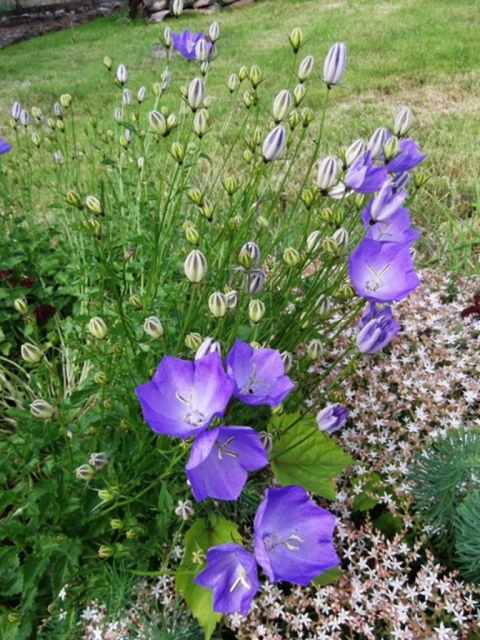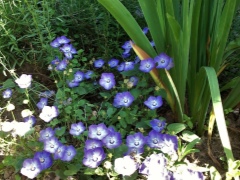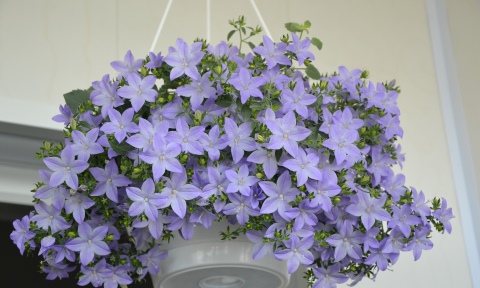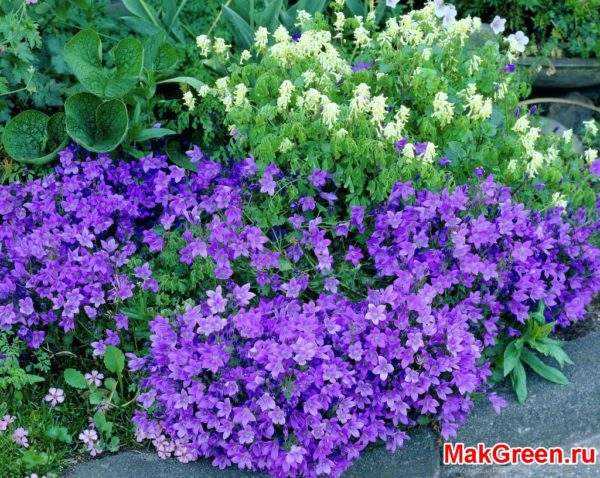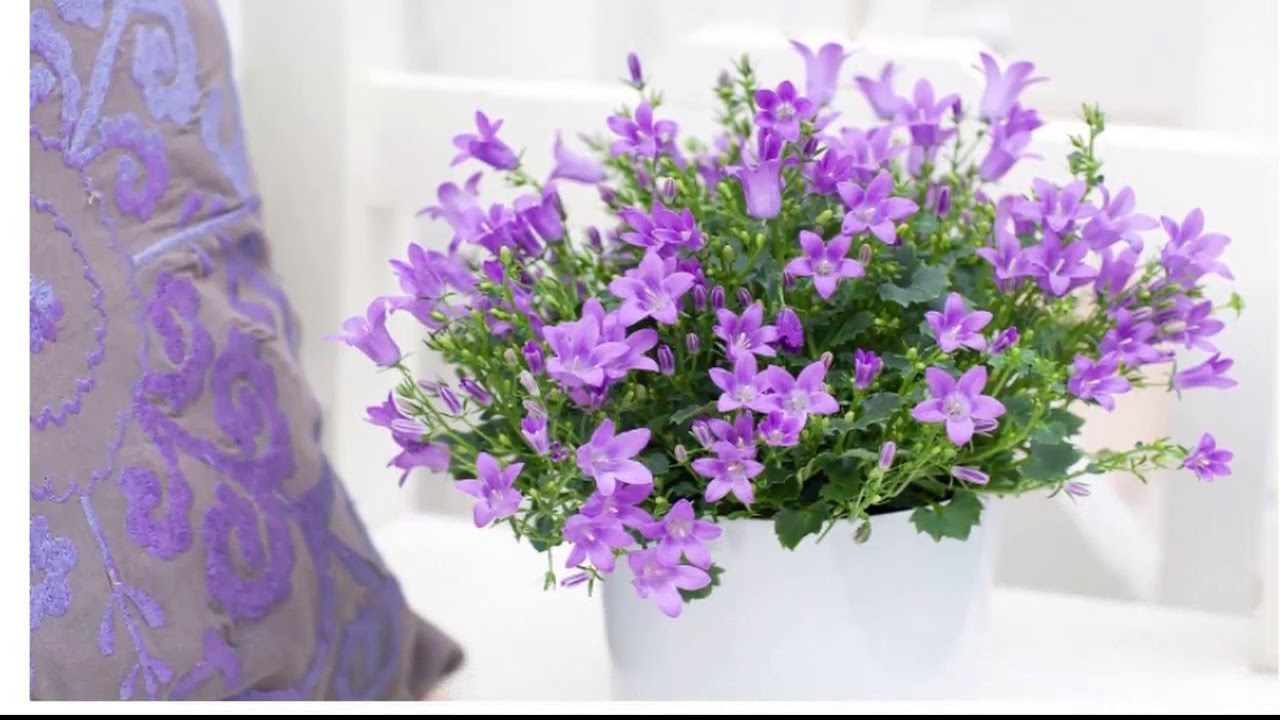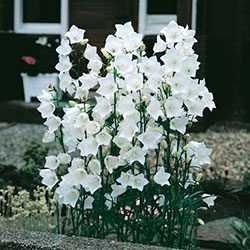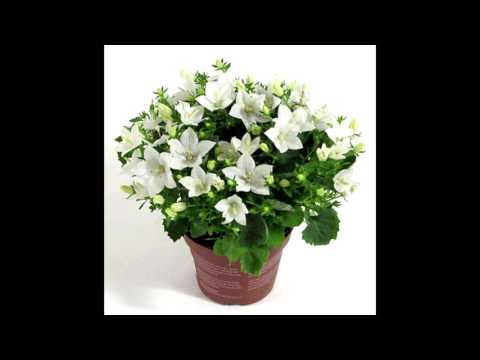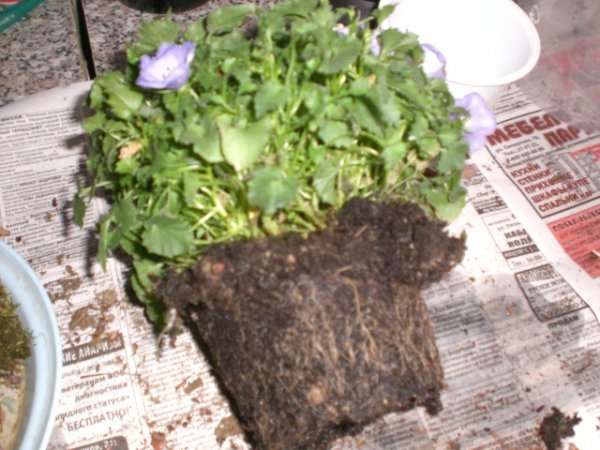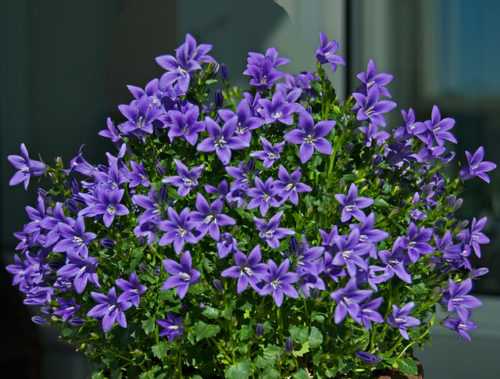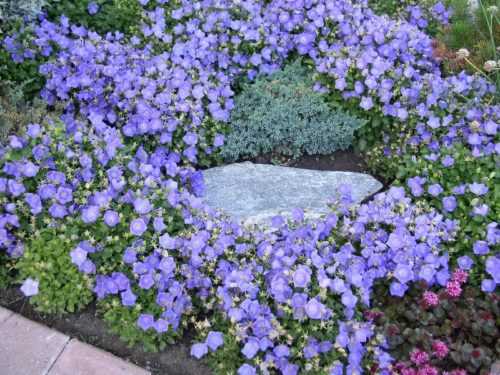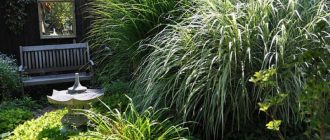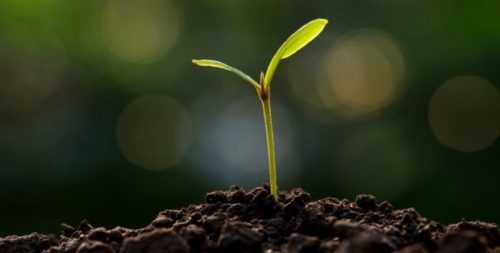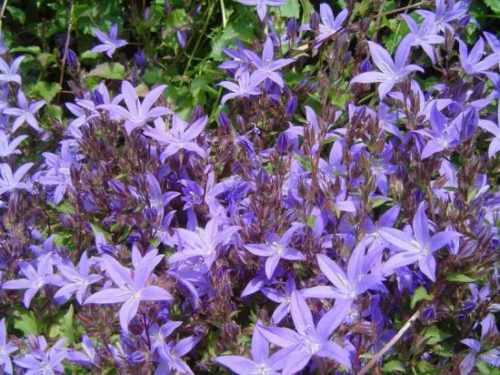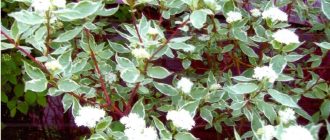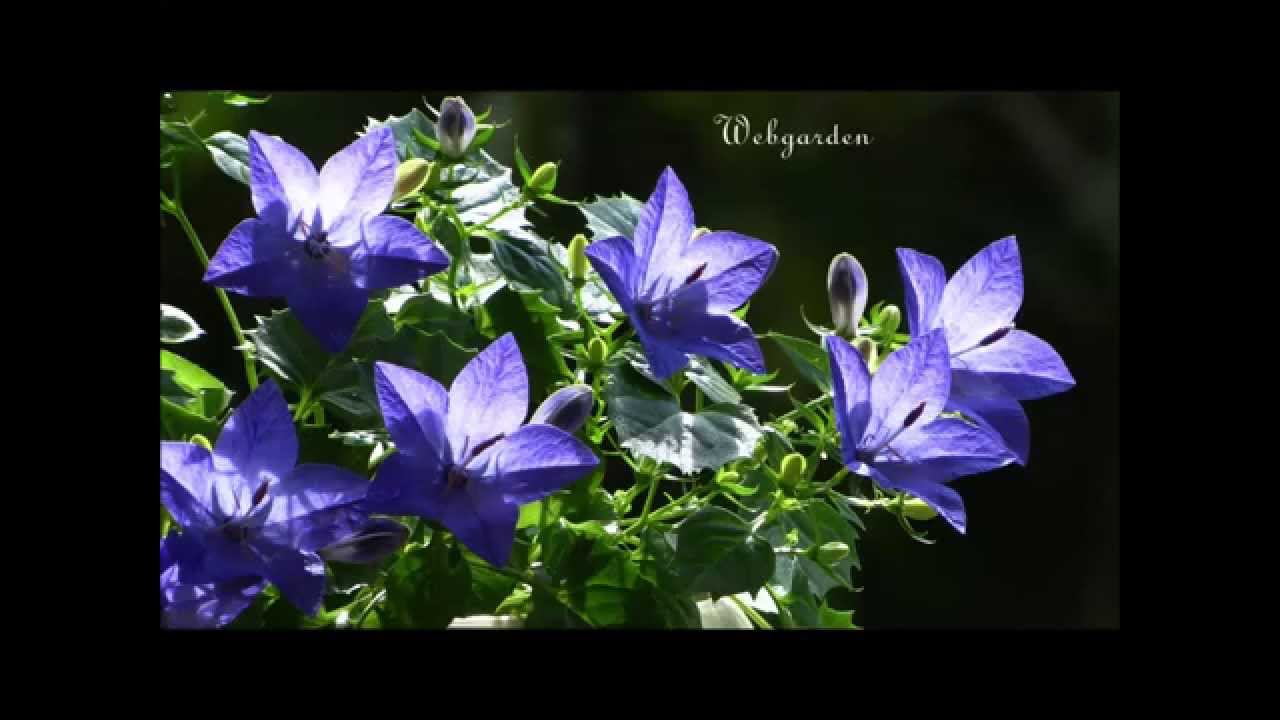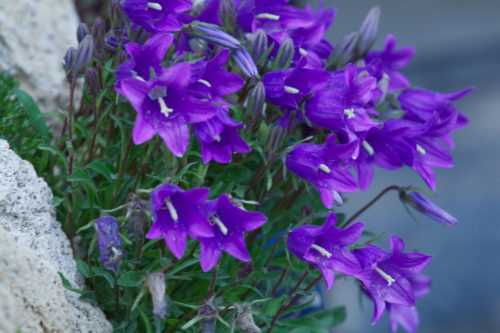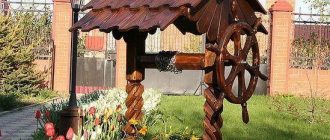Is it possible to plant in open ground - care rules
Often novice gardeners are worried whether it is possible to plant a campanula on the street or not? Natural species are not capricious and frost-resistant, suitable for growing in a garden and a backyard. Cultivars are more demanding to care for. Outdoor Campanula can be planted and replanted in spring and fall.
The soil
Campanula outdoors prefers loamy, slightly alkaline or neutral soil. Too wet soil is detrimental to the flower. If the groundwater is located close to the surface, it is advisable to plant the bell on a hill.
Reducing the acidity of the soil is quite simple, just add wood ash. Sandy soil is mixed with humus, and clay soil with sand or peat.
Top dressing of perennial bells
The plant is fed every 14 days, during active flowering. Ornamental varieties need fertilization two or three times a month. In the spring, nitrogen-containing fertilizers are applied to the soil. During the budding period, mineral complex fertilizers are used. Before flowering itself, potash or phosphate fertilizers are added to the soil. In the fall, after the inflorescences have faded, the plant is fed with potassium and superphosphate.
Important! It is forbidden to fertilize the plant with fresh manure, after which the roots begin to rot
Loosening and weeding
In summer, campanula in the country needs regular weeding. Weeds not only worsen the appearance of the site, but also harm the plant. Weeds are the habitat of many pests and insects that infest shrubs and negatively affect plant development. After weeding, water the bushes and loosen the soil under them. This process provides oxygen to the root system.

Loosening and weeding
Location and lighting
In nature, campanula prefers well-lit places, as well as partial shade. An ideal planting site would be the eastern or western part of the site. Direct sunlight can burn leaves. At lunchtime, it is advisable to shade the bushes. In the fall, before planting the plant in the ground, the site must be dug up and organic matter added.
Pruning and wintering
After the last inflorescence has faded, the bell must be cut off. In the process, long shoots are removed. Then dry inflorescences are cut off, this has a positive effect on the laying of new buds. Then mulching with peat is carried out, the root zone is insulated with dry leaves. In the spring, the shelter is removed, otherwise the flower may oppose. Pruning is carried out in early spring, dried parts of the plant are removed.
Bellflower: plant propagation
Reproduction of campanula can be carried out by seedlings, dividing a bush or cuttings. Terry or semi-double varieties are obtained only by vegetative methods, if the task is to preserve the properties of the mother plant. The beginning of summer is the optimal time for propagation by cuttings. To settle down in a new place, they will need about 1 month. and minimal maintenance:
- cut the annual flowering shoot from a healthy adult plant;
- plant in loose soil;
- shade the shank.
Even a novice florist can handle the reproduction of campanula.
Reproduction by division is planned for the end of spring or summer. The plant is removed, several parts are formed from it. Each should have aboveground and underground parts, as well as several growth buds. After that, the cuttings are immediately planted in open ground.
To properly harvest the seeds, wait until the capsule matures to a dark brown color. Then proceed like this:
- dry the seeds;
- in October, plant them in open ground and sprinkle them with a thin layer of soil;
- water if the soil is dry.
With proper care, you will see seedlings in April-May. They are planted in a permanent place in June or July. Seedlings can also be obtained at home:
- find a wide container, because the root of the plant is quite large;
- plant seeds after watering the soil in a pot;
- do not deepen the planting material, but scatter it evenly over the surface;
- build a mini greenhouse;
- open it for 15 minutes once a day, ventilate and spray the greens with a spray bottle;
- for open ground, seedlings will get stronger in about 20 days.
Outdoor Handbell Care
Care rules
They must be grown in the same way as other flowers in the garden. Bells are distinguished by their unpretentiousness. Watering is carried out only in the case of a prolonged dry and hot period. To loosen the soil surface and remove weeds, it is recommended after irrigation. If necessary, tall varieties can be tied to a support. The first feeding is carried out in the spring on melted snow and nitrogen fertilizer is used for this. The second time is fed in the first half of the summer period, when buds begin to form and for this they use a complex fertilizer. Regular removal of wilted flowers will allow the flowering period to be longer.
Reproduction of bells
Annual plants can only be propagated by seeds, and biennial plants can be propagated by seeds, as well as by cuttings in spring. Bells, which are perennials, are propagated: by parts of the rhizome, stolons, root cuttings, as well as by dividing the bush. Seeds of perennial species may not retain varietal characteristics. In terry varieties, seeds do not appear at all and only a vegetative method is used for reproduction.
Those perennials that have a pivotal or carpal system of roots are vegetatively immobile, and they are grown exclusively from seeds. Species with a short rhizome are classified as vegetatively inactive, and cuttings and division are used for their reproduction. Species with creeping long rhizomes are considered vegetatively mobile, and seeds, cuttings, rhizome pieces, root suckers are used for their reproduction, and you can also divide a bush.
Sowing seeds for seedlings is described above. They can also be sown in open soil in mid-October. In winter, they will not freeze out, but will undergo a completely natural stratification. In springtime, you will see dense shoots. After the plants grow up, they will need to be planted. Sowing seeds in open soil can be done in May. But in this case, the seeds will need preparation, or rather, stratification in the refrigerator (in a vegetable drawer), where they should stay for 8 weeks. However, annuals reproduce well by self-sowing, and therefore the difficulties associated with spring sowing can be completely avoided.
Cuttings are harvested in the spring. So, in March or April, you should cut them from young stem or basal stems. For planting, loose and light soil is used. Cover the cuttings with a transparent film so that they are always in high humidity. A greenhouse with a mist sprayer is ideal for rooting cuttings. After 3-4 weeks, the cuttings should take root.
As a rule, bushes older than 3-5 years are used for dividing. But there are species that are suitable for division already in the second year of life. It is necessary to dig out large bushes in the first days of May or at the end of the summer period. They cut off all the shoots, and then divide the rhizome into parts using a very sharp pre-sterilized knife. Make sure that renewal buds and well-developed roots are present on each division.Sections must be processed with chopped charcoal, and then immediately plant the cuttings in a permanent place.
In order to propagate by parts of the roots, you need to dig out the creeping rhizome and cut it into pieces. Please note that each such division must have a renewal bud. Then they are planted in the soil so that the buds are at the level of the soil surface.
The root offspring separated from the mother plant is immediately planted in a permanent place.
Pests and diseases
Bells have a very beautiful appearance, and they are distinguished by their unpretentiousness. These plants are highly resistant to diseases and harmful insects and get sick in very rare cases. But if perennials are grown for a long time without transplanting, then the accumulation of pathogens (sclerotinia, fusarium or botrytis) can occur in the soil, which can completely destroy the bells. In order to avoid this, it is necessary in the spring and autumn to carry out one treatment of plants with a solution of Fundazol (0.2%).
A slobbering penny can appear on bushes in wet weather. Infected plants are treated with garlic infusion. Low-growing species can be affected by slugs. In this case, processing is carried out with a decoction of hot pepper, and granular superphosphate must be scattered over the surface of the soil.
Getting bellflower seedlings from seeds
This method is laborious and time-consuming, but it allows you to get good seedlings of flowers even in cold regions. To get dense seedlings, seeds are sown in small boxes (pots can be used) with a substrate. Sowing is carried out from February to the end of March.

Seedling container
First, you need to prepare containers for future seedlings with a certain amount of fertile land. If it is not possible to purchase a substrate specifically for the bell, you can prepare it yourself. For this, sod, organic humus and river sand are mixed.
It is important to respect the proportions. They are equal to 6: 3: 1, respectively.
Before planting the seed, the substrate is well moistened with water
After that, all the seeds are scattered over the surface of the substrate and slapped slightly, but this should be done without sprinkling with earth.
All containers are tightly closed with oilcloth or transparent glass. After that, the boxes or pots are placed in a well-heated room with natural light. The best fit is an equestrian window facing the west or south side of the world.
To prevent the seedlings from burning, the boxes should be opened for a while for the flow of fresh air every day for 14 days. Additionally, the soil is moistened with water at room temperature from a spray bottle.
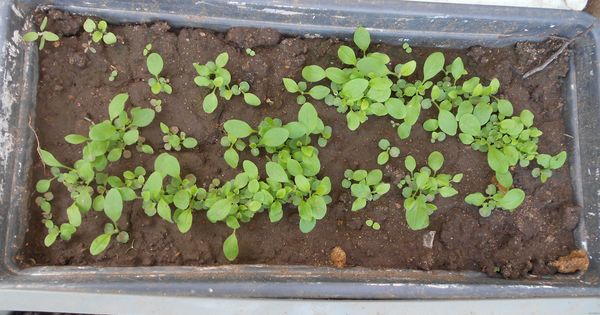
Seedling of Carpathian bell
The first seedlings appear in the third week. After she sprouts with leaves, they should be planted in small containers, ordinary cups from yogurt or sour cream will do. 2-3 plants dive into each one, then observing the watering regime. Serious drying out or excessive moisture of the soil must not be allowed. In May, all seedlings can already be planted in the ground. In addition, information on growing can be found in the video.
How and when to sow Carpathian bell for seedlings
Growing seedlings should start in March. Sowing seeds is superficial, under a transparent cover or glass.
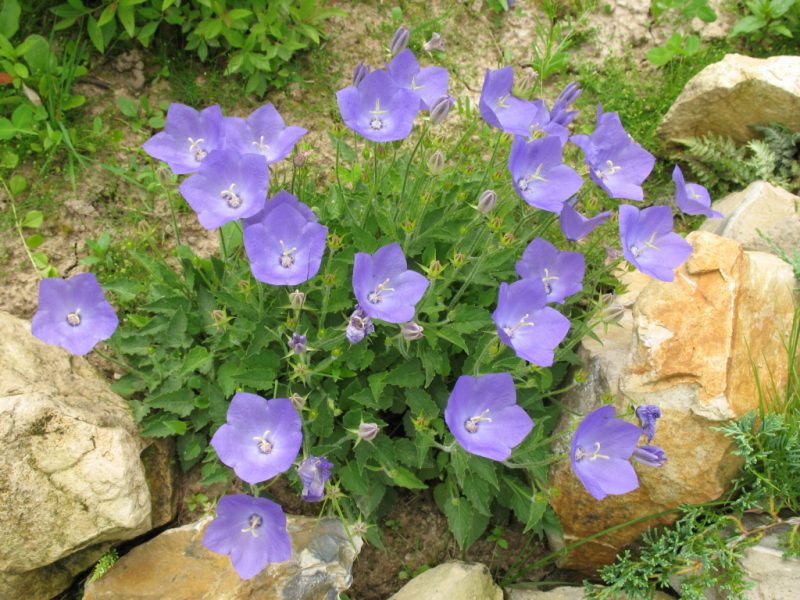
Pay attention to the requirements for the location, it must be:
- light, warm, no drafts;
- with additional light, energy-saving or special phytolamps;
- with a constant temperature not lower than 20 ℃.
Watering is carried out every 10 days when the soil is dry. Seedlings appear in two to three weeks.After another week, the seedlings begin to gradually harden: first remove the lid for 10-15 minutes, gradually increasing the time and bringing it to 2 hours, and then leaving it open overnight.
After the appearance of the third leaf, the seedlings are transplanted so that the distance between them is at least 30 cm. Plan the planting of seedlings on the site at the end of May.
Advice. The plant has long roots, so it is best to grow seedlings in tall pots.
Growing flowers from seeds
This method allows you to easily and quickly propagate elegant flowers on the site. Plants grow best on neutral, slightly alkaline soils. Flowers do not develop well in acidic soils. Therefore, clay soils are "diluted" with humus, compost at the rate of fifteen kilograms per square meter of area. If the soils are loamy, then 19 kilograms of humus are introduced per square meter of area.
Bells need well-lit areas to grow fully. Although flowers develop well in shaded areas. The bell "Cup and saucer" grows superbly under fences, where soil moisture is well preserved. Therefore, it is often planted near the eastern or western walls. But the flowers do not tolerate stagnant water and in very damp areas, the bells are simply overheated.
Seedling growing stages
For rapid seed germination, mix turf soil, sand and humus in a ratio of 6: 1: 3. The soil mixture should be loose, slightly damp.
- In the last days of March, small seeds are planted in moist soil. It is not necessary to sprinkle the planting material with earth, you can lightly sprinkle it with sand.
- The container with seeds is sprayed with water, covered with foil or glass and placed in a warm, dark place (air temperature is about 20 ° C). It should be borne in mind that seeds may not germinate in the light. Therefore, glass or film is covered with dark paper or thick dark material.
- Planting material germinates in 2-3 weeks. The covering layer is removed, and the container is placed in a well-lit place. But you should avoid direct sunlight on the sprouts.
Seedling care consists in periodically irrigating the soil and gently loosening it around the seedlings. Watering the ground should be done when its top layer dries.
As soon as the first leaves appear on the sprouts (after about 3-3.5 weeks), the "Cup and saucer" bell is dived - seated in separate containers. You can simply transplant the plants into one large box (the distance between the shoots is at least 10 cm). After another two weeks, fertilizing is introduced in liquid form. It is recommended to combine watering and fertilization.
With the seedling method of breeding bells, it will be possible to admire elegant inflorescences in the form of cups and saucers already this year.
Sowing seeds in open ground
A common option for breeding bells is sowing planting material in a summer cottage directly into the ground. You can set aside time for this both in the spring and in the fall.
In the last days of October, seeds are planted in an area protected from the winds. Only strong seeds can overwinter, so strong shoots appear in the spring. Already at the end of April - beginning of May, you can plant sprouts in permanent places (flower beds, flower beds).
When sowing in spring, the seeds are pre-stratified (approximately two months before planting). To do this, they are kept in a solution of potassium permanganate (about an hour). Then the planting material is washed, placed on a moistened cloth. To prevent the canvas from drying out quickly, it is placed together with the seeds in a plastic bag and placed in the refrigerator. It is possible to plant planting material in open ground in the second half of May.
When breeding bells in this way, it must be borne in mind that plants in the first year of life direct all their forces to the formation of a strong root system, to the development of leaf rosettes.Therefore, flowering can be expected only in the second year, when shoots with flower ovaries appear.
In order for the flowers to grow fully, they are planted at a distance of at least 30 cm from each other. To maintain soil moisture, the ground between the bells is mulched.
Bright reward for hard work - exquisite bouquets
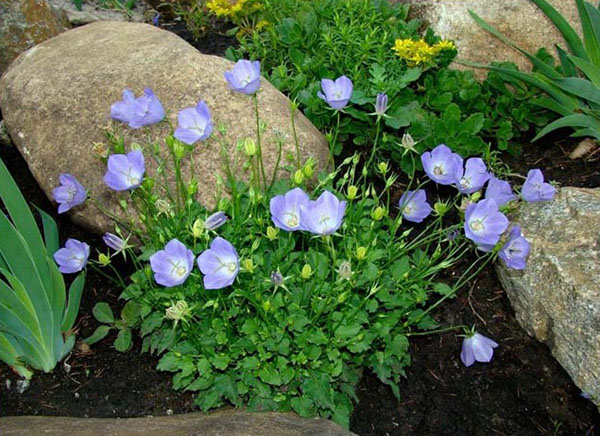
Practice shows that the planting material of a plant is considered very capricious. But do not lose heart, just be patient and act
First of all, it is important to know when to plant Carpathian bell for seedlingsto successfully propagate the flower. It is this method that allows you to enjoy its flowering this year.
To grow seedlings, planting material is sown in early March or late February.
It is advisable to sow seeds in open ground in mid-May in spring or in early November in autumn.
First, a high-quality permeable soil is prepared by mixing sod land with humus and coarse river sand (6: 3: 1). The finished mixture is disinfected in a preheated oven for about 40 minutes. Some gardeners use a water bath for this purpose.

The next stage is the preparation of planting material. It is soaked in warm water for 5 hours to increase the germination of the plant.
Then they start planting the plant, performing the following procedures:
- the containers are filled with the substrate;
- moisten the surface with a spray bottle;
- sowing seeds;
- lightly press down the crops with your hand, without covering them with a layer of soil;
- glass or plastic wrap is placed on top of the containers;
- the boxes are placed in a warm and bright room.
Before the first greenery appears, the surface of the earth is regularly moistened. If the crops are covered with glass, condensation is removed from its inner surface every day. It is enough to ventilate the film in the fresh air. The first shoots appear in about 25 days.
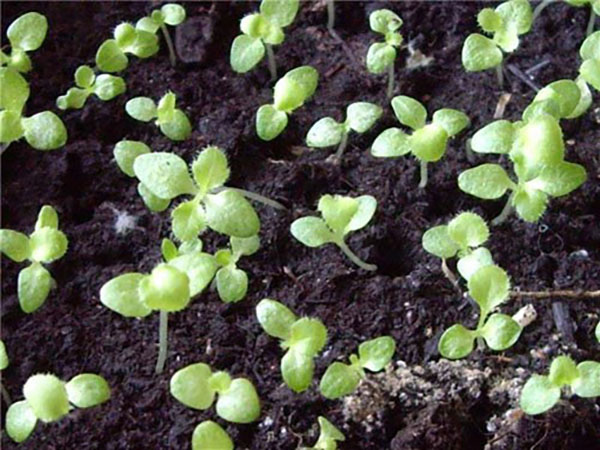
The temperature of the room where the crops are placed must be at least 20 ° C.
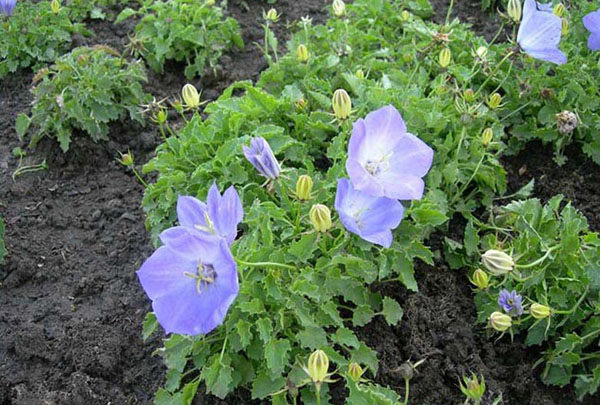
In order for the plant to adapt to the external environment, stabbing is carried out. To do this, the containers are opened for 20 minutes every day. When the seedlings rise to 5 cm, the cover is removed. Dense crops dive, leaving more robust varieties. All this time, they are moistened with a sprayer. In May, when the soil warms up well, the sprouts are planted in a flower bed or alpine hill.

As you can see, any effort is always rewarded. Various varieties of Carpathian bells are increasingly appearing on flower beds near country houses. Why not give yourself such a bright pleasure? It is enough to pick up the tools and act according to the established rule.
Carpathian bell: combination with other plants
On an alpine slide, perennial bells are ideally combined in plantings with rock alyssum, shaved, lobelia, daisies and other perennial or annual plants for rocky gardens.
 The bell looks great in a flowerbed with other perennials
The bell looks great in a flowerbed with other perennials
The combination of blue and white bells, planted side by side, is very picturesque. Photos of landscape compositions using campanula confirm the perfect combination of blue bells with flowers of white, pink and yellow shades.
The plant is ideally combined with the emerald carpet of urban lawns.
Brief conclusions
Garden campanula is a flower that has about 300 varieties. Such a variety of species will allow you to easily choose a plant just for your flower arrangement.
To grow a crop, you need to choose the right piece of land. She needs sunlight, but diffused. Partial shade is allowed, the main thing is not strong shading, otherwise the foliage will suffer.
The Campanula bell requires a lot of water. It is watered once a day, and during a drought, the moisture rate is doubled.
The water should be at room temperature.
It is important to regularly loosen, ensuring oxygen flow to the root system.This ensures a lush bloom.
In some varieties, in order to achieve re-budding, dried flowers should be removed in time.
Culture needs shelter for the winter
You can protect the roots with peat or fallen leaves.

